LEMT305 Reflective Journal: Leadership Theories and Practical Use
VerifiedAdded on 2023/06/11
|9
|2706
|330
Journal and Reflective Writing
AI Summary
This reflective journal delves into the concepts and theories of leadership, emphasizing their application to personal experiences and practical knowledge. It identifies various leadership styles and underscores the importance of leadership qualities for managers. The journal reflects on how leadership is applied within teams and organizations, focusing on enhancing skills to develop effective leadership practices. It covers contemporary theories, behavioral theories, and the impact of leader personalities and values. The reflection extends to understanding diversity in the workplace, the significance of transformational leadership, and the development of moral values within organizations. The journal also emphasizes the importance of communication, team building, and strategic leadership in achieving organizational goals. The student reflects on the effectiveness of different leadership styles and their impact on organizational processes and employee motivation.
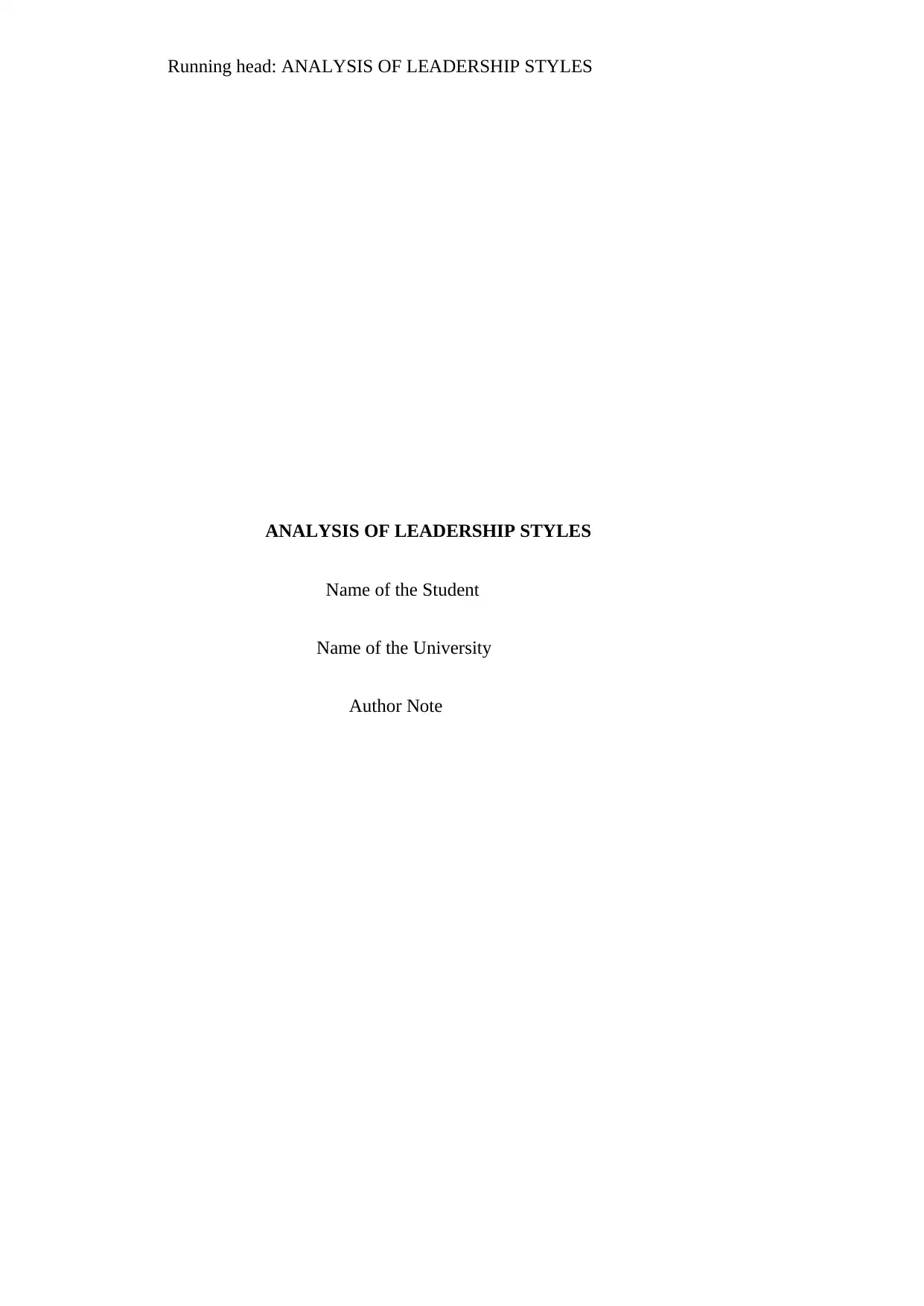
Running head: ANALYSIS OF LEADERSHIP STYLES
ANALYSIS OF LEADERSHIP STYLES
Name of the Student
Name of the University
Author Note
ANALYSIS OF LEADERSHIP STYLES
Name of the Student
Name of the University
Author Note
Paraphrase This Document
Need a fresh take? Get an instant paraphrase of this document with our AI Paraphraser
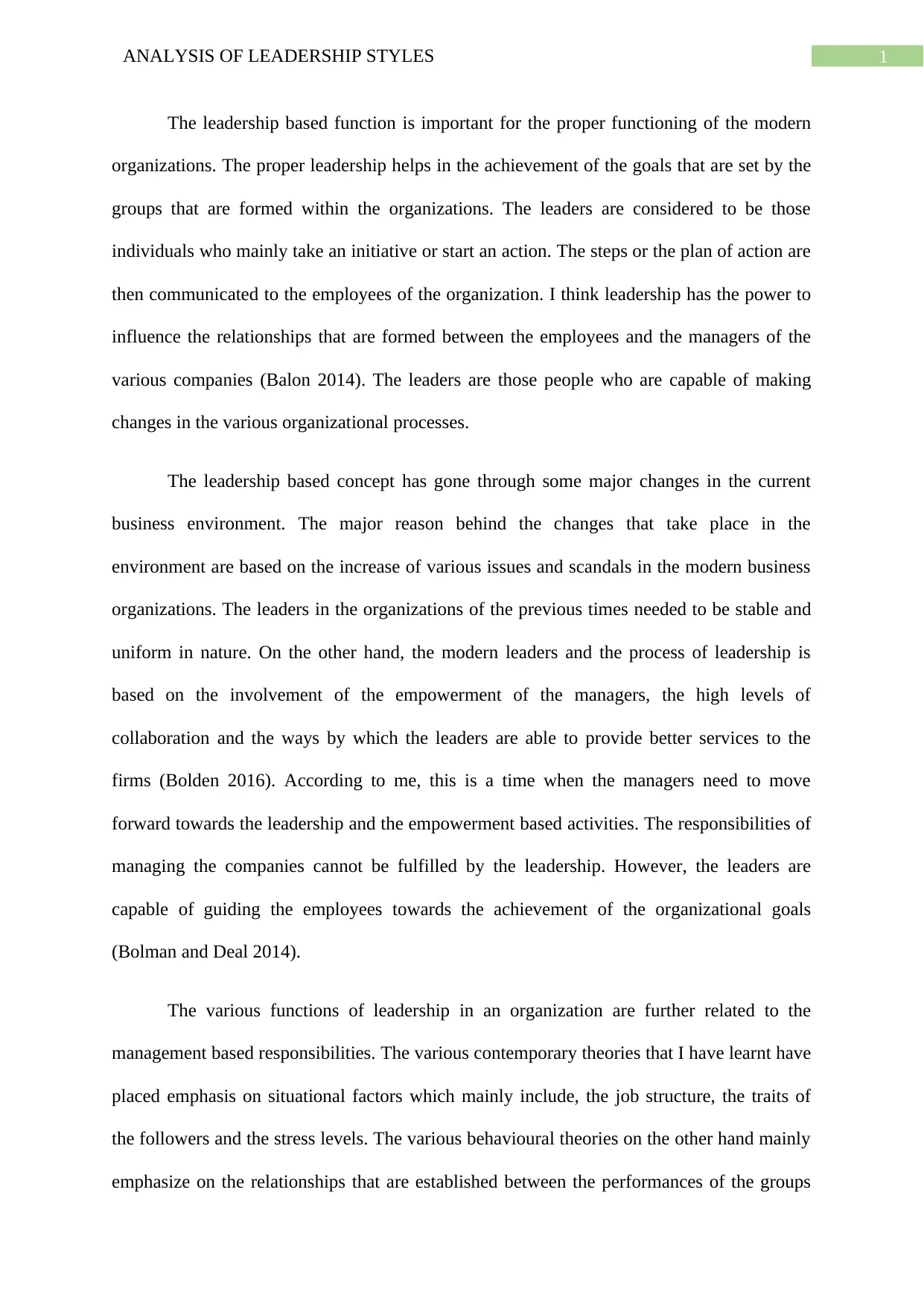
1ANALYSIS OF LEADERSHIP STYLES
The leadership based function is important for the proper functioning of the modern
organizations. The proper leadership helps in the achievement of the goals that are set by the
groups that are formed within the organizations. The leaders are considered to be those
individuals who mainly take an initiative or start an action. The steps or the plan of action are
then communicated to the employees of the organization. I think leadership has the power to
influence the relationships that are formed between the employees and the managers of the
various companies (Balon 2014). The leaders are those people who are capable of making
changes in the various organizational processes.
The leadership based concept has gone through some major changes in the current
business environment. The major reason behind the changes that take place in the
environment are based on the increase of various issues and scandals in the modern business
organizations. The leaders in the organizations of the previous times needed to be stable and
uniform in nature. On the other hand, the modern leaders and the process of leadership is
based on the involvement of the empowerment of the managers, the high levels of
collaboration and the ways by which the leaders are able to provide better services to the
firms (Bolden 2016). According to me, this is a time when the managers need to move
forward towards the leadership and the empowerment based activities. The responsibilities of
managing the companies cannot be fulfilled by the leadership. However, the leaders are
capable of guiding the employees towards the achievement of the organizational goals
(Bolman and Deal 2014).
The various functions of leadership in an organization are further related to the
management based responsibilities. The various contemporary theories that I have learnt have
placed emphasis on situational factors which mainly include, the job structure, the traits of
the followers and the stress levels. The various behavioural theories on the other hand mainly
emphasize on the relationships that are established between the performances of the groups
The leadership based function is important for the proper functioning of the modern
organizations. The proper leadership helps in the achievement of the goals that are set by the
groups that are formed within the organizations. The leaders are considered to be those
individuals who mainly take an initiative or start an action. The steps or the plan of action are
then communicated to the employees of the organization. I think leadership has the power to
influence the relationships that are formed between the employees and the managers of the
various companies (Balon 2014). The leaders are those people who are capable of making
changes in the various organizational processes.
The leadership based concept has gone through some major changes in the current
business environment. The major reason behind the changes that take place in the
environment are based on the increase of various issues and scandals in the modern business
organizations. The leaders in the organizations of the previous times needed to be stable and
uniform in nature. On the other hand, the modern leaders and the process of leadership is
based on the involvement of the empowerment of the managers, the high levels of
collaboration and the ways by which the leaders are able to provide better services to the
firms (Bolden 2016). According to me, this is a time when the managers need to move
forward towards the leadership and the empowerment based activities. The responsibilities of
managing the companies cannot be fulfilled by the leadership. However, the leaders are
capable of guiding the employees towards the achievement of the organizational goals
(Bolman and Deal 2014).
The various functions of leadership in an organization are further related to the
management based responsibilities. The various contemporary theories that I have learnt have
placed emphasis on situational factors which mainly include, the job structure, the traits of
the followers and the stress levels. The various behavioural theories on the other hand mainly
emphasize on the relationships that are established between the performances of the groups
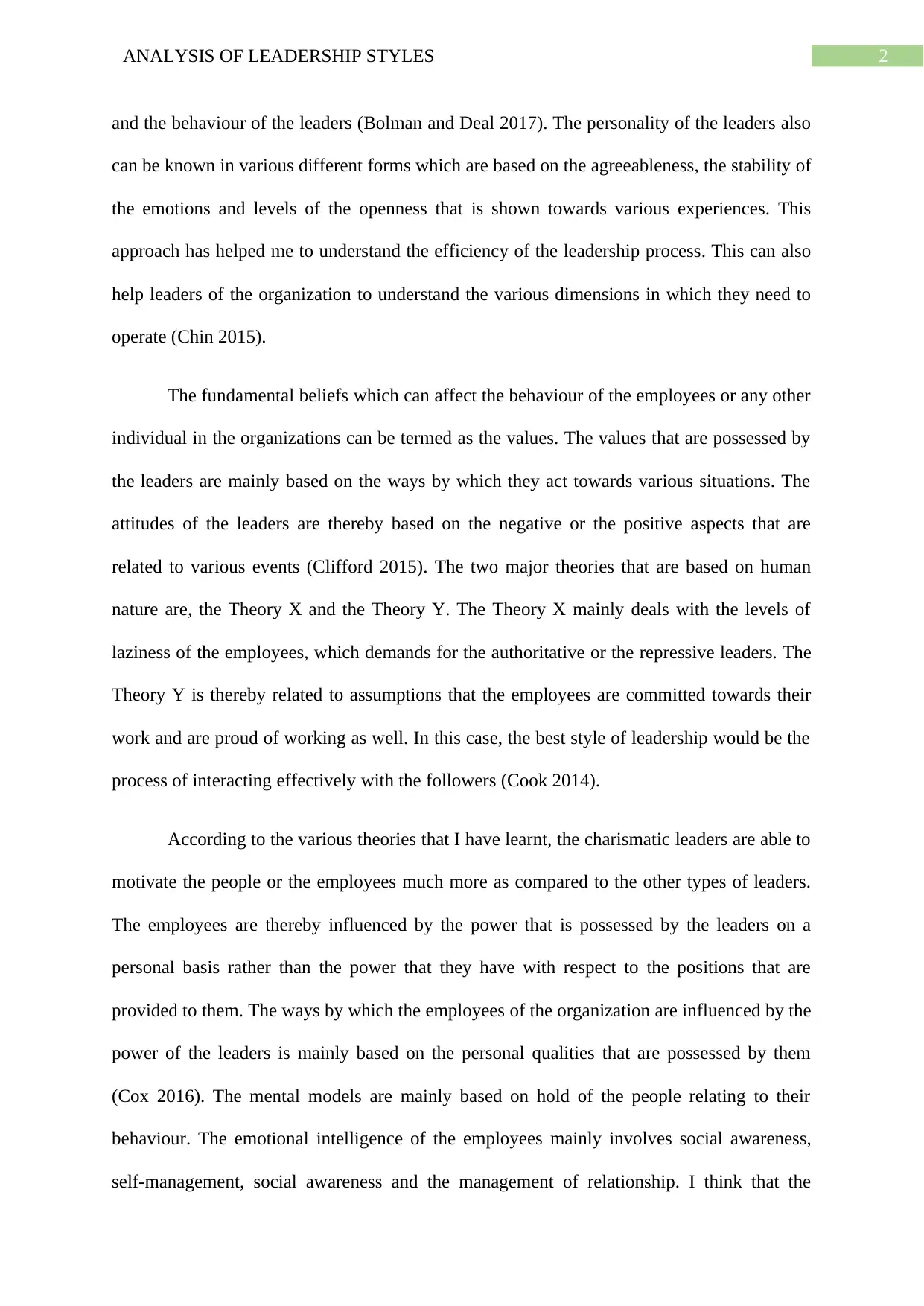
2ANALYSIS OF LEADERSHIP STYLES
and the behaviour of the leaders (Bolman and Deal 2017). The personality of the leaders also
can be known in various different forms which are based on the agreeableness, the stability of
the emotions and levels of the openness that is shown towards various experiences. This
approach has helped me to understand the efficiency of the leadership process. This can also
help leaders of the organization to understand the various dimensions in which they need to
operate (Chin 2015).
The fundamental beliefs which can affect the behaviour of the employees or any other
individual in the organizations can be termed as the values. The values that are possessed by
the leaders are mainly based on the ways by which they act towards various situations. The
attitudes of the leaders are thereby based on the negative or the positive aspects that are
related to various events (Clifford 2015). The two major theories that are based on human
nature are, the Theory X and the Theory Y. The Theory X mainly deals with the levels of
laziness of the employees, which demands for the authoritative or the repressive leaders. The
Theory Y is thereby related to assumptions that the employees are committed towards their
work and are proud of working as well. In this case, the best style of leadership would be the
process of interacting effectively with the followers (Cook 2014).
According to the various theories that I have learnt, the charismatic leaders are able to
motivate the people or the employees much more as compared to the other types of leaders.
The employees are thereby influenced by the power that is possessed by the leaders on a
personal basis rather than the power that they have with respect to the positions that are
provided to them. The ways by which the employees of the organization are influenced by the
power of the leaders is mainly based on the personal qualities that are possessed by them
(Cox 2016). The mental models are mainly based on hold of the people relating to their
behaviour. The emotional intelligence of the employees mainly involves social awareness,
self-management, social awareness and the management of relationship. I think that the
and the behaviour of the leaders (Bolman and Deal 2017). The personality of the leaders also
can be known in various different forms which are based on the agreeableness, the stability of
the emotions and levels of the openness that is shown towards various experiences. This
approach has helped me to understand the efficiency of the leadership process. This can also
help leaders of the organization to understand the various dimensions in which they need to
operate (Chin 2015).
The fundamental beliefs which can affect the behaviour of the employees or any other
individual in the organizations can be termed as the values. The values that are possessed by
the leaders are mainly based on the ways by which they act towards various situations. The
attitudes of the leaders are thereby based on the negative or the positive aspects that are
related to various events (Clifford 2015). The two major theories that are based on human
nature are, the Theory X and the Theory Y. The Theory X mainly deals with the levels of
laziness of the employees, which demands for the authoritative or the repressive leaders. The
Theory Y is thereby related to assumptions that the employees are committed towards their
work and are proud of working as well. In this case, the best style of leadership would be the
process of interacting effectively with the followers (Cook 2014).
According to the various theories that I have learnt, the charismatic leaders are able to
motivate the people or the employees much more as compared to the other types of leaders.
The employees are thereby influenced by the power that is possessed by the leaders on a
personal basis rather than the power that they have with respect to the positions that are
provided to them. The ways by which the employees of the organization are influenced by the
power of the leaders is mainly based on the personal qualities that are possessed by them
(Cox 2016). The mental models are mainly based on hold of the people relating to their
behaviour. The emotional intelligence of the employees mainly involves social awareness,
self-management, social awareness and the management of relationship. I think that the
⊘ This is a preview!⊘
Do you want full access?
Subscribe today to unlock all pages.

Trusted by 1+ million students worldwide
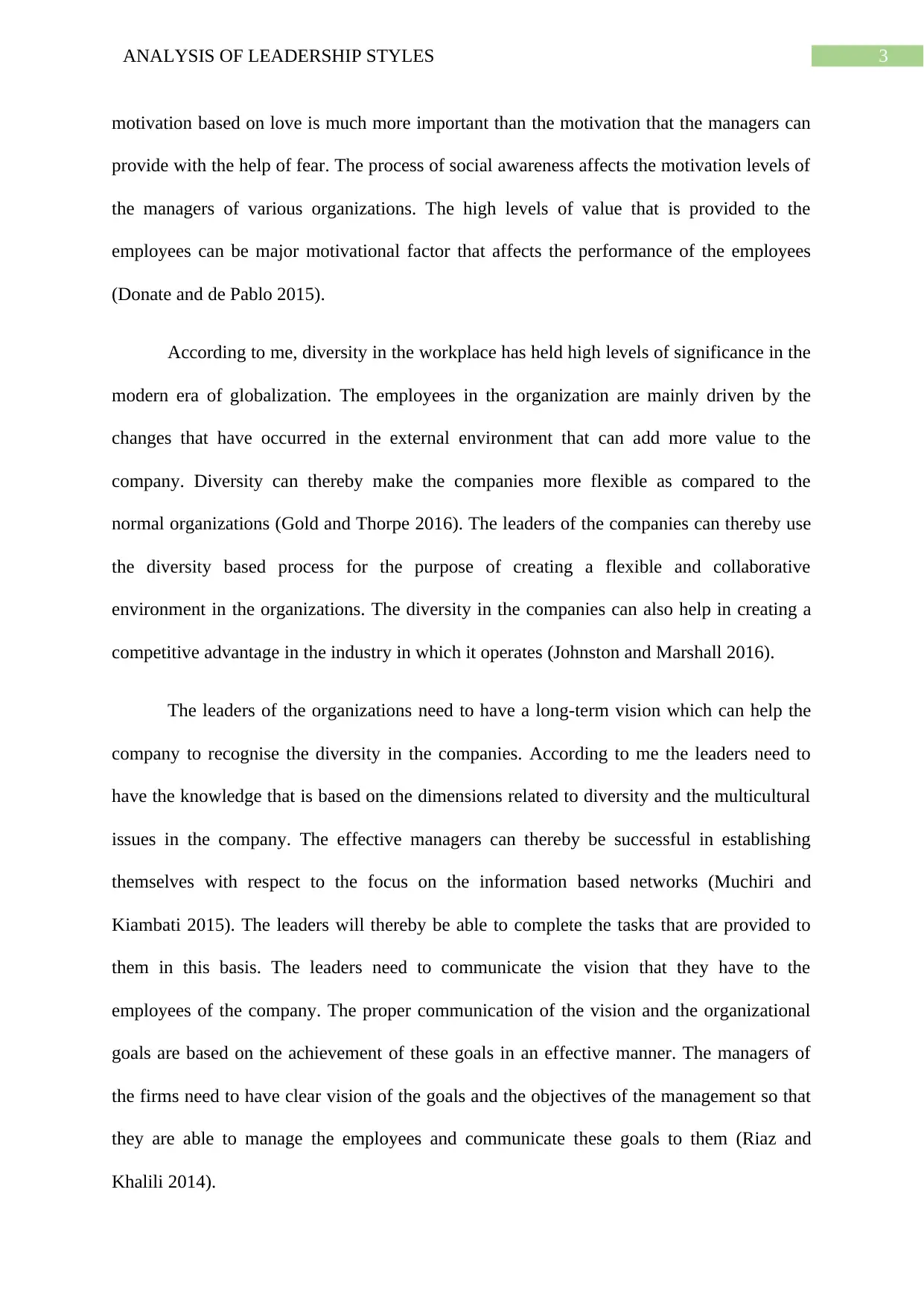
3ANALYSIS OF LEADERSHIP STYLES
motivation based on love is much more important than the motivation that the managers can
provide with the help of fear. The process of social awareness affects the motivation levels of
the managers of various organizations. The high levels of value that is provided to the
employees can be major motivational factor that affects the performance of the employees
(Donate and de Pablo 2015).
According to me, diversity in the workplace has held high levels of significance in the
modern era of globalization. The employees in the organization are mainly driven by the
changes that have occurred in the external environment that can add more value to the
company. Diversity can thereby make the companies more flexible as compared to the
normal organizations (Gold and Thorpe 2016). The leaders of the companies can thereby use
the diversity based process for the purpose of creating a flexible and collaborative
environment in the organizations. The diversity in the companies can also help in creating a
competitive advantage in the industry in which it operates (Johnston and Marshall 2016).
The leaders of the organizations need to have a long-term vision which can help the
company to recognise the diversity in the companies. According to me the leaders need to
have the knowledge that is based on the dimensions related to diversity and the multicultural
issues in the company. The effective managers can thereby be successful in establishing
themselves with respect to the focus on the information based networks (Muchiri and
Kiambati 2015). The leaders will thereby be able to complete the tasks that are provided to
them in this basis. The leaders need to communicate the vision that they have to the
employees of the company. The proper communication of the vision and the organizational
goals are based on the achievement of these goals in an effective manner. The managers of
the firms need to have clear vision of the goals and the objectives of the management so that
they are able to manage the employees and communicate these goals to them (Riaz and
Khalili 2014).
motivation based on love is much more important than the motivation that the managers can
provide with the help of fear. The process of social awareness affects the motivation levels of
the managers of various organizations. The high levels of value that is provided to the
employees can be major motivational factor that affects the performance of the employees
(Donate and de Pablo 2015).
According to me, diversity in the workplace has held high levels of significance in the
modern era of globalization. The employees in the organization are mainly driven by the
changes that have occurred in the external environment that can add more value to the
company. Diversity can thereby make the companies more flexible as compared to the
normal organizations (Gold and Thorpe 2016). The leaders of the companies can thereby use
the diversity based process for the purpose of creating a flexible and collaborative
environment in the organizations. The diversity in the companies can also help in creating a
competitive advantage in the industry in which it operates (Johnston and Marshall 2016).
The leaders of the organizations need to have a long-term vision which can help the
company to recognise the diversity in the companies. According to me the leaders need to
have the knowledge that is based on the dimensions related to diversity and the multicultural
issues in the company. The effective managers can thereby be successful in establishing
themselves with respect to the focus on the information based networks (Muchiri and
Kiambati 2015). The leaders will thereby be able to complete the tasks that are provided to
them in this basis. The leaders need to communicate the vision that they have to the
employees of the company. The proper communication of the vision and the organizational
goals are based on the achievement of these goals in an effective manner. The managers of
the firms need to have clear vision of the goals and the objectives of the management so that
they are able to manage the employees and communicate these goals to them (Riaz and
Khalili 2014).
Paraphrase This Document
Need a fresh take? Get an instant paraphrase of this document with our AI Paraphraser
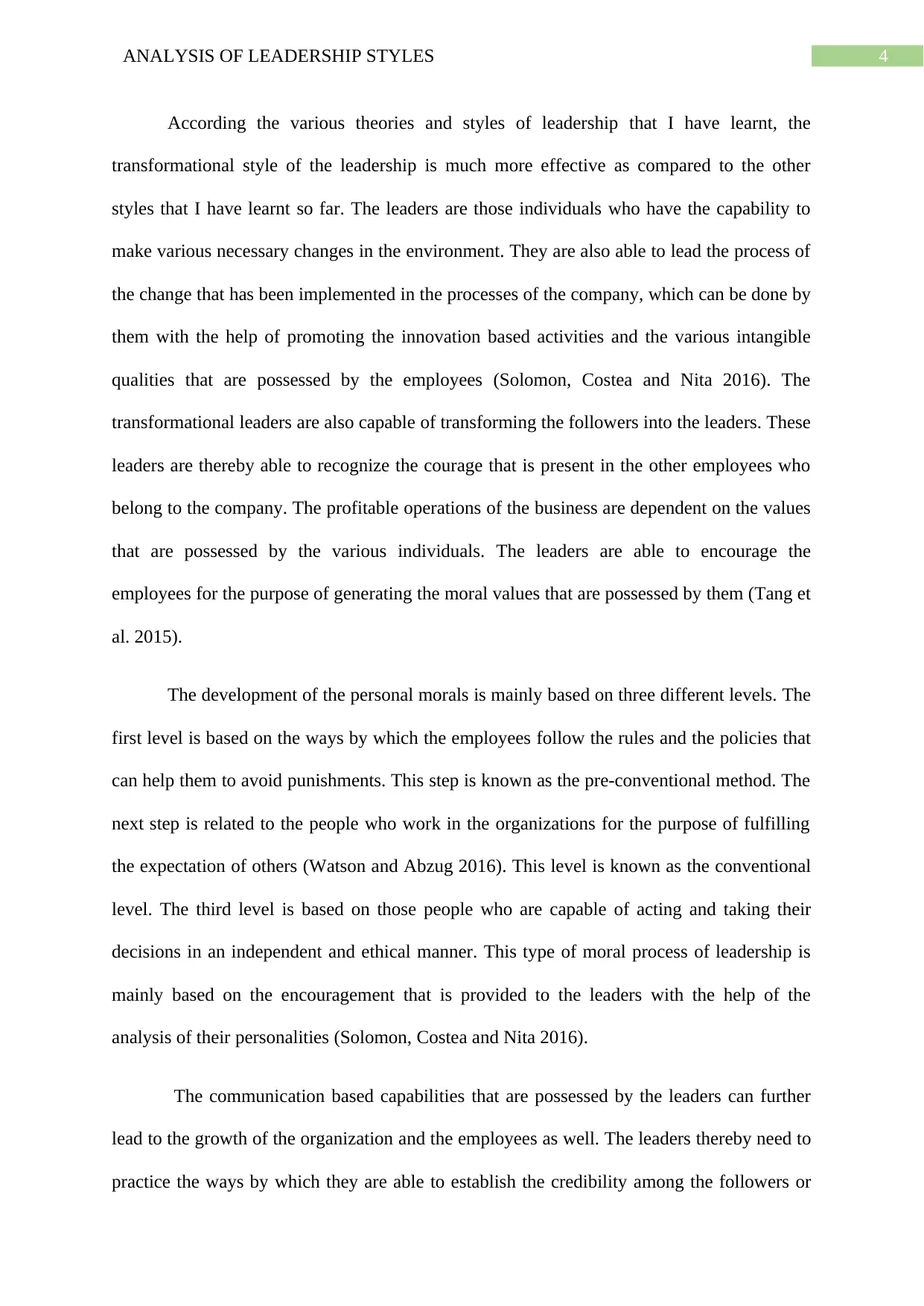
4ANALYSIS OF LEADERSHIP STYLES
According the various theories and styles of leadership that I have learnt, the
transformational style of the leadership is much more effective as compared to the other
styles that I have learnt so far. The leaders are those individuals who have the capability to
make various necessary changes in the environment. They are also able to lead the process of
the change that has been implemented in the processes of the company, which can be done by
them with the help of promoting the innovation based activities and the various intangible
qualities that are possessed by the employees (Solomon, Costea and Nita 2016). The
transformational leaders are also capable of transforming the followers into the leaders. These
leaders are thereby able to recognize the courage that is present in the other employees who
belong to the company. The profitable operations of the business are dependent on the values
that are possessed by the various individuals. The leaders are able to encourage the
employees for the purpose of generating the moral values that are possessed by them (Tang et
al. 2015).
The development of the personal morals is mainly based on three different levels. The
first level is based on the ways by which the employees follow the rules and the policies that
can help them to avoid punishments. This step is known as the pre-conventional method. The
next step is related to the people who work in the organizations for the purpose of fulfilling
the expectation of others (Watson and Abzug 2016). This level is known as the conventional
level. The third level is based on those people who are capable of acting and taking their
decisions in an independent and ethical manner. This type of moral process of leadership is
mainly based on the encouragement that is provided to the leaders with the help of the
analysis of their personalities (Solomon, Costea and Nita 2016).
The communication based capabilities that are possessed by the leaders can further
lead to the growth of the organization and the employees as well. The leaders thereby need to
practice the ways by which they are able to establish the credibility among the followers or
According the various theories and styles of leadership that I have learnt, the
transformational style of the leadership is much more effective as compared to the other
styles that I have learnt so far. The leaders are those individuals who have the capability to
make various necessary changes in the environment. They are also able to lead the process of
the change that has been implemented in the processes of the company, which can be done by
them with the help of promoting the innovation based activities and the various intangible
qualities that are possessed by the employees (Solomon, Costea and Nita 2016). The
transformational leaders are also capable of transforming the followers into the leaders. These
leaders are thereby able to recognize the courage that is present in the other employees who
belong to the company. The profitable operations of the business are dependent on the values
that are possessed by the various individuals. The leaders are able to encourage the
employees for the purpose of generating the moral values that are possessed by them (Tang et
al. 2015).
The development of the personal morals is mainly based on three different levels. The
first level is based on the ways by which the employees follow the rules and the policies that
can help them to avoid punishments. This step is known as the pre-conventional method. The
next step is related to the people who work in the organizations for the purpose of fulfilling
the expectation of others (Watson and Abzug 2016). This level is known as the conventional
level. The third level is based on those people who are capable of acting and taking their
decisions in an independent and ethical manner. This type of moral process of leadership is
mainly based on the encouragement that is provided to the leaders with the help of the
analysis of their personalities (Solomon, Costea and Nita 2016).
The communication based capabilities that are possessed by the leaders can further
lead to the growth of the organization and the employees as well. The leaders thereby need to
practice the ways by which they are able to establish the credibility among the followers or
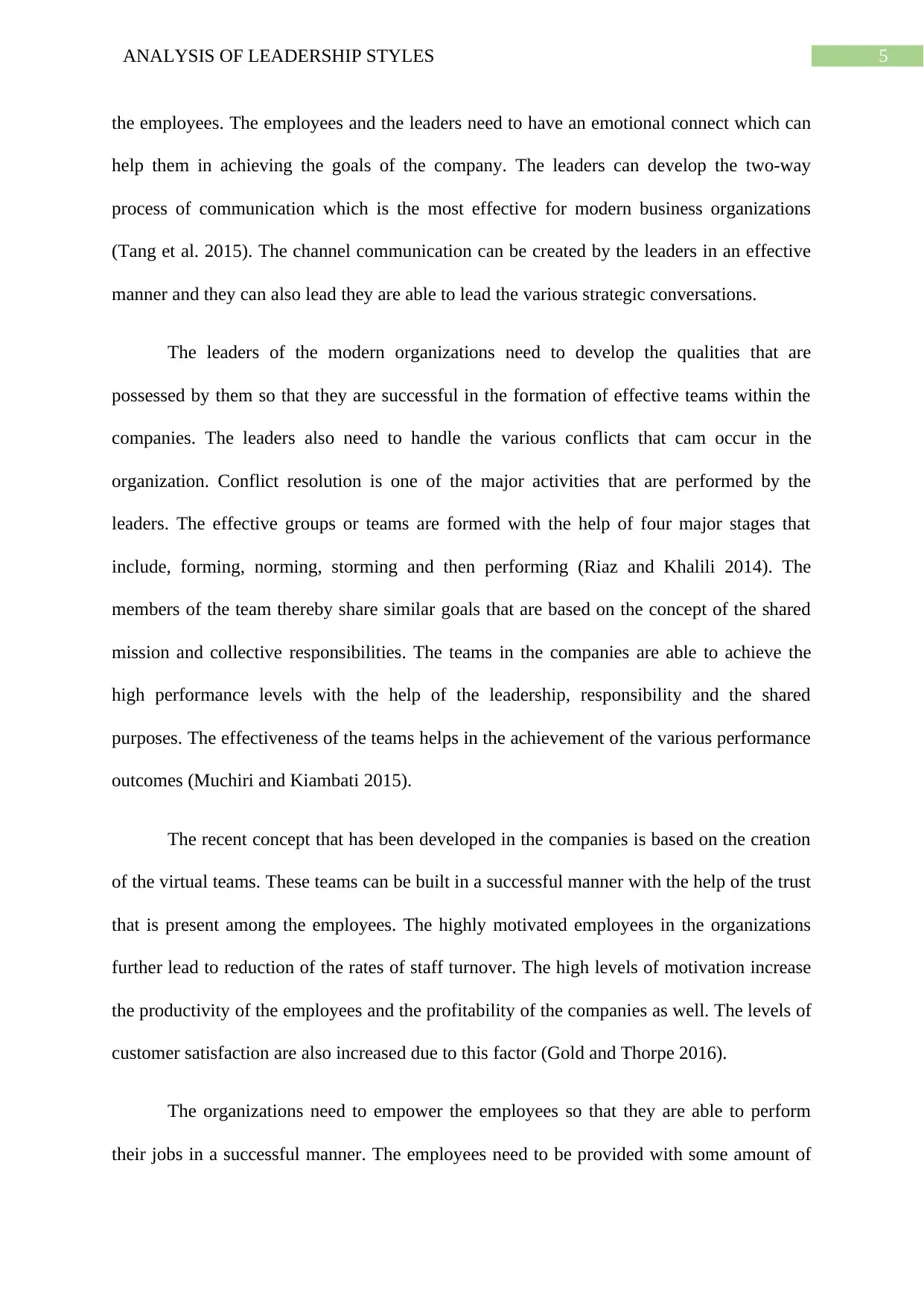
5ANALYSIS OF LEADERSHIP STYLES
the employees. The employees and the leaders need to have an emotional connect which can
help them in achieving the goals of the company. The leaders can develop the two-way
process of communication which is the most effective for modern business organizations
(Tang et al. 2015). The channel communication can be created by the leaders in an effective
manner and they can also lead they are able to lead the various strategic conversations.
The leaders of the modern organizations need to develop the qualities that are
possessed by them so that they are successful in the formation of effective teams within the
companies. The leaders also need to handle the various conflicts that cam occur in the
organization. Conflict resolution is one of the major activities that are performed by the
leaders. The effective groups or teams are formed with the help of four major stages that
include, forming, norming, storming and then performing (Riaz and Khalili 2014). The
members of the team thereby share similar goals that are based on the concept of the shared
mission and collective responsibilities. The teams in the companies are able to achieve the
high performance levels with the help of the leadership, responsibility and the shared
purposes. The effectiveness of the teams helps in the achievement of the various performance
outcomes (Muchiri and Kiambati 2015).
The recent concept that has been developed in the companies is based on the creation
of the virtual teams. These teams can be built in a successful manner with the help of the trust
that is present among the employees. The highly motivated employees in the organizations
further lead to reduction of the rates of staff turnover. The high levels of motivation increase
the productivity of the employees and the profitability of the companies as well. The levels of
customer satisfaction are also increased due to this factor (Gold and Thorpe 2016).
The organizations need to empower the employees so that they are able to perform
their jobs in a successful manner. The employees need to be provided with some amount of
the employees. The employees and the leaders need to have an emotional connect which can
help them in achieving the goals of the company. The leaders can develop the two-way
process of communication which is the most effective for modern business organizations
(Tang et al. 2015). The channel communication can be created by the leaders in an effective
manner and they can also lead they are able to lead the various strategic conversations.
The leaders of the modern organizations need to develop the qualities that are
possessed by them so that they are successful in the formation of effective teams within the
companies. The leaders also need to handle the various conflicts that cam occur in the
organization. Conflict resolution is one of the major activities that are performed by the
leaders. The effective groups or teams are formed with the help of four major stages that
include, forming, norming, storming and then performing (Riaz and Khalili 2014). The
members of the team thereby share similar goals that are based on the concept of the shared
mission and collective responsibilities. The teams in the companies are able to achieve the
high performance levels with the help of the leadership, responsibility and the shared
purposes. The effectiveness of the teams helps in the achievement of the various performance
outcomes (Muchiri and Kiambati 2015).
The recent concept that has been developed in the companies is based on the creation
of the virtual teams. These teams can be built in a successful manner with the help of the trust
that is present among the employees. The highly motivated employees in the organizations
further lead to reduction of the rates of staff turnover. The high levels of motivation increase
the productivity of the employees and the profitability of the companies as well. The levels of
customer satisfaction are also increased due to this factor (Gold and Thorpe 2016).
The organizations need to empower the employees so that they are able to perform
their jobs in a successful manner. The employees need to be provided with some amount of
⊘ This is a preview!⊘
Do you want full access?
Subscribe today to unlock all pages.

Trusted by 1+ million students worldwide
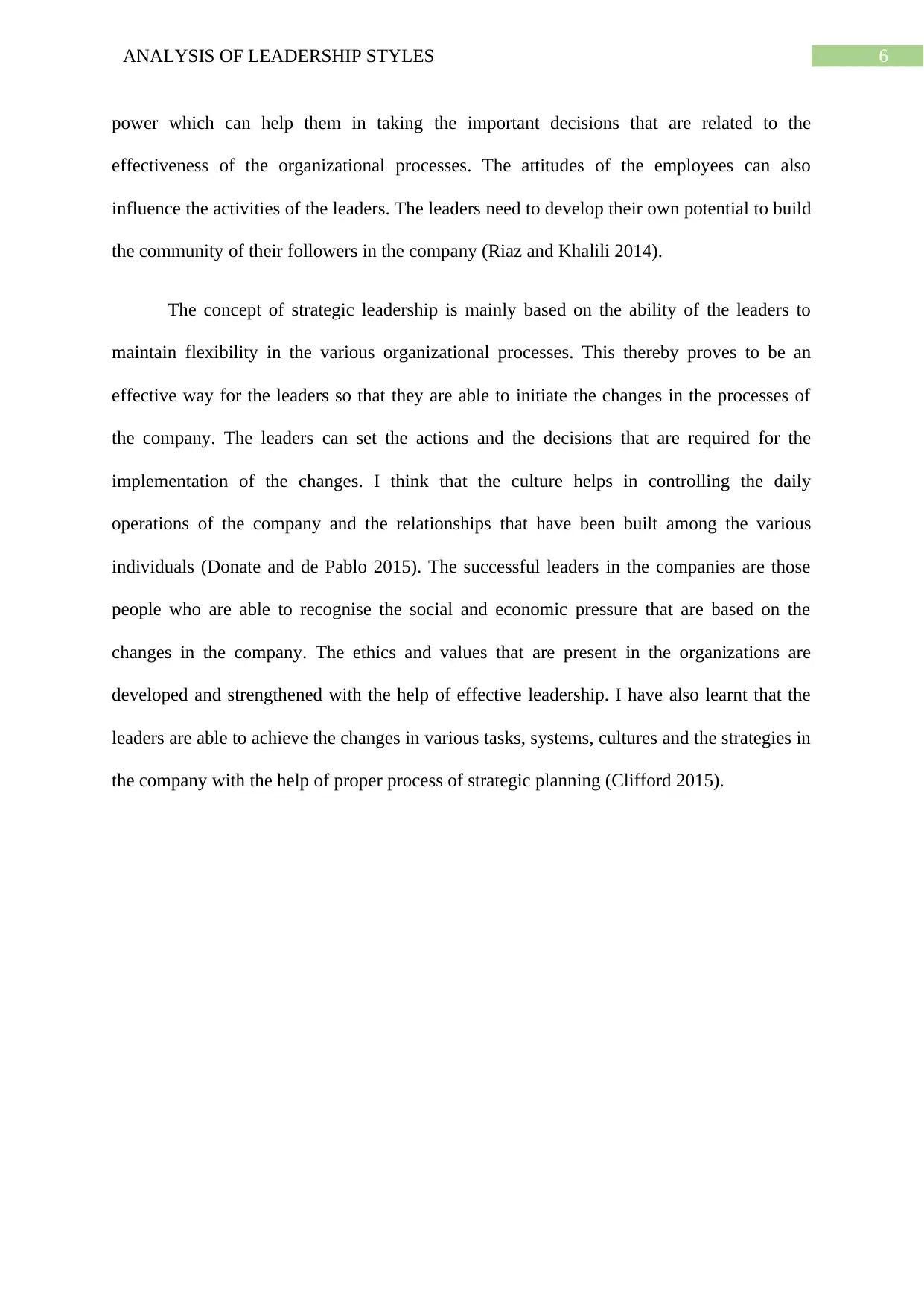
6ANALYSIS OF LEADERSHIP STYLES
power which can help them in taking the important decisions that are related to the
effectiveness of the organizational processes. The attitudes of the employees can also
influence the activities of the leaders. The leaders need to develop their own potential to build
the community of their followers in the company (Riaz and Khalili 2014).
The concept of strategic leadership is mainly based on the ability of the leaders to
maintain flexibility in the various organizational processes. This thereby proves to be an
effective way for the leaders so that they are able to initiate the changes in the processes of
the company. The leaders can set the actions and the decisions that are required for the
implementation of the changes. I think that the culture helps in controlling the daily
operations of the company and the relationships that have been built among the various
individuals (Donate and de Pablo 2015). The successful leaders in the companies are those
people who are able to recognise the social and economic pressure that are based on the
changes in the company. The ethics and values that are present in the organizations are
developed and strengthened with the help of effective leadership. I have also learnt that the
leaders are able to achieve the changes in various tasks, systems, cultures and the strategies in
the company with the help of proper process of strategic planning (Clifford 2015).
power which can help them in taking the important decisions that are related to the
effectiveness of the organizational processes. The attitudes of the employees can also
influence the activities of the leaders. The leaders need to develop their own potential to build
the community of their followers in the company (Riaz and Khalili 2014).
The concept of strategic leadership is mainly based on the ability of the leaders to
maintain flexibility in the various organizational processes. This thereby proves to be an
effective way for the leaders so that they are able to initiate the changes in the processes of
the company. The leaders can set the actions and the decisions that are required for the
implementation of the changes. I think that the culture helps in controlling the daily
operations of the company and the relationships that have been built among the various
individuals (Donate and de Pablo 2015). The successful leaders in the companies are those
people who are able to recognise the social and economic pressure that are based on the
changes in the company. The ethics and values that are present in the organizations are
developed and strengthened with the help of effective leadership. I have also learnt that the
leaders are able to achieve the changes in various tasks, systems, cultures and the strategies in
the company with the help of proper process of strategic planning (Clifford 2015).
Paraphrase This Document
Need a fresh take? Get an instant paraphrase of this document with our AI Paraphraser
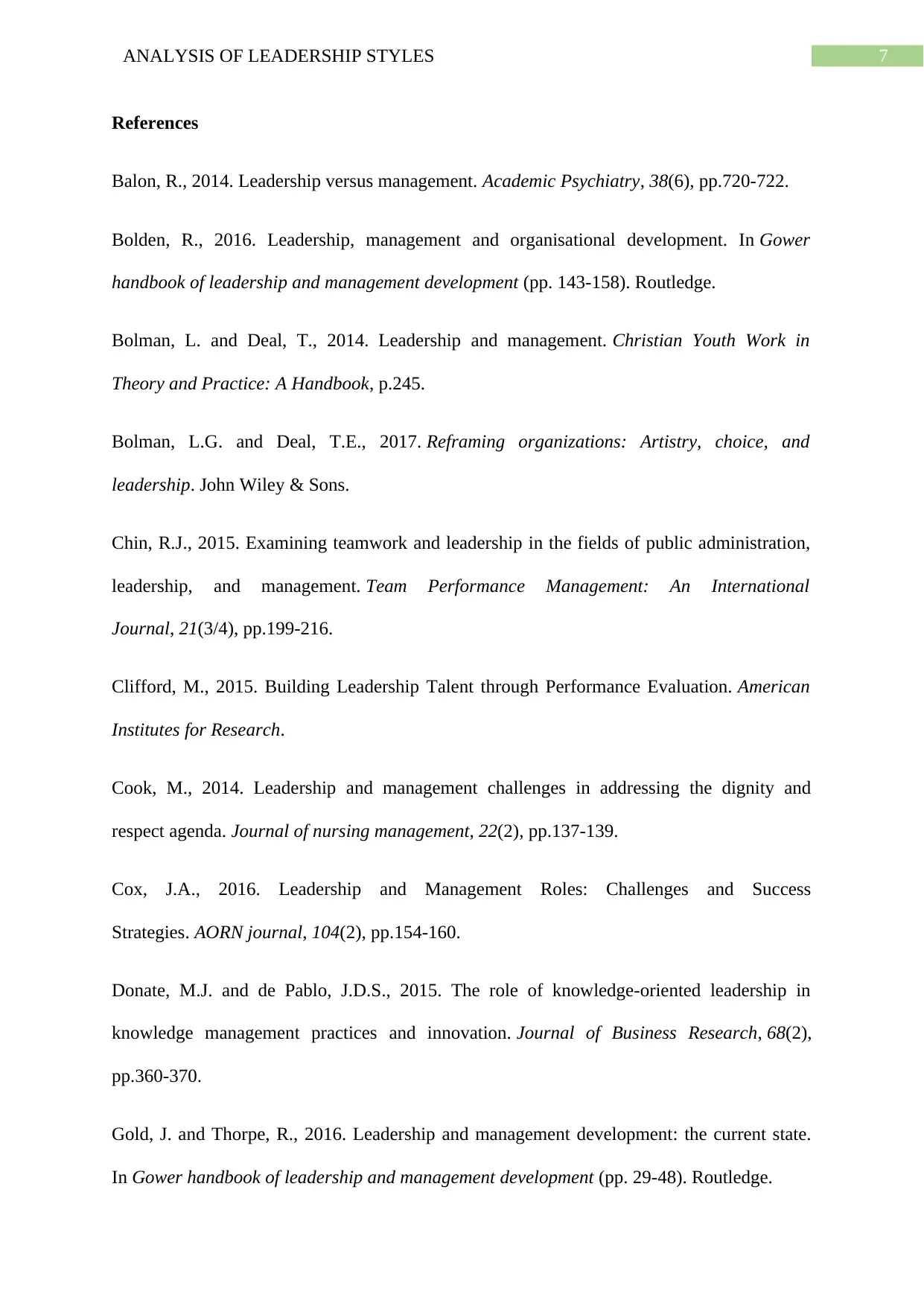
7ANALYSIS OF LEADERSHIP STYLES
References
Balon, R., 2014. Leadership versus management. Academic Psychiatry, 38(6), pp.720-722.
Bolden, R., 2016. Leadership, management and organisational development. In Gower
handbook of leadership and management development (pp. 143-158). Routledge.
Bolman, L. and Deal, T., 2014. Leadership and management. Christian Youth Work in
Theory and Practice: A Handbook, p.245.
Bolman, L.G. and Deal, T.E., 2017. Reframing organizations: Artistry, choice, and
leadership. John Wiley & Sons.
Chin, R.J., 2015. Examining teamwork and leadership in the fields of public administration,
leadership, and management. Team Performance Management: An International
Journal, 21(3/4), pp.199-216.
Clifford, M., 2015. Building Leadership Talent through Performance Evaluation. American
Institutes for Research.
Cook, M., 2014. Leadership and management challenges in addressing the dignity and
respect agenda. Journal of nursing management, 22(2), pp.137-139.
Cox, J.A., 2016. Leadership and Management Roles: Challenges and Success
Strategies. AORN journal, 104(2), pp.154-160.
Donate, M.J. and de Pablo, J.D.S., 2015. The role of knowledge-oriented leadership in
knowledge management practices and innovation. Journal of Business Research, 68(2),
pp.360-370.
Gold, J. and Thorpe, R., 2016. Leadership and management development: the current state.
In Gower handbook of leadership and management development (pp. 29-48). Routledge.
References
Balon, R., 2014. Leadership versus management. Academic Psychiatry, 38(6), pp.720-722.
Bolden, R., 2016. Leadership, management and organisational development. In Gower
handbook of leadership and management development (pp. 143-158). Routledge.
Bolman, L. and Deal, T., 2014. Leadership and management. Christian Youth Work in
Theory and Practice: A Handbook, p.245.
Bolman, L.G. and Deal, T.E., 2017. Reframing organizations: Artistry, choice, and
leadership. John Wiley & Sons.
Chin, R.J., 2015. Examining teamwork and leadership in the fields of public administration,
leadership, and management. Team Performance Management: An International
Journal, 21(3/4), pp.199-216.
Clifford, M., 2015. Building Leadership Talent through Performance Evaluation. American
Institutes for Research.
Cook, M., 2014. Leadership and management challenges in addressing the dignity and
respect agenda. Journal of nursing management, 22(2), pp.137-139.
Cox, J.A., 2016. Leadership and Management Roles: Challenges and Success
Strategies. AORN journal, 104(2), pp.154-160.
Donate, M.J. and de Pablo, J.D.S., 2015. The role of knowledge-oriented leadership in
knowledge management practices and innovation. Journal of Business Research, 68(2),
pp.360-370.
Gold, J. and Thorpe, R., 2016. Leadership and management development: the current state.
In Gower handbook of leadership and management development (pp. 29-48). Routledge.
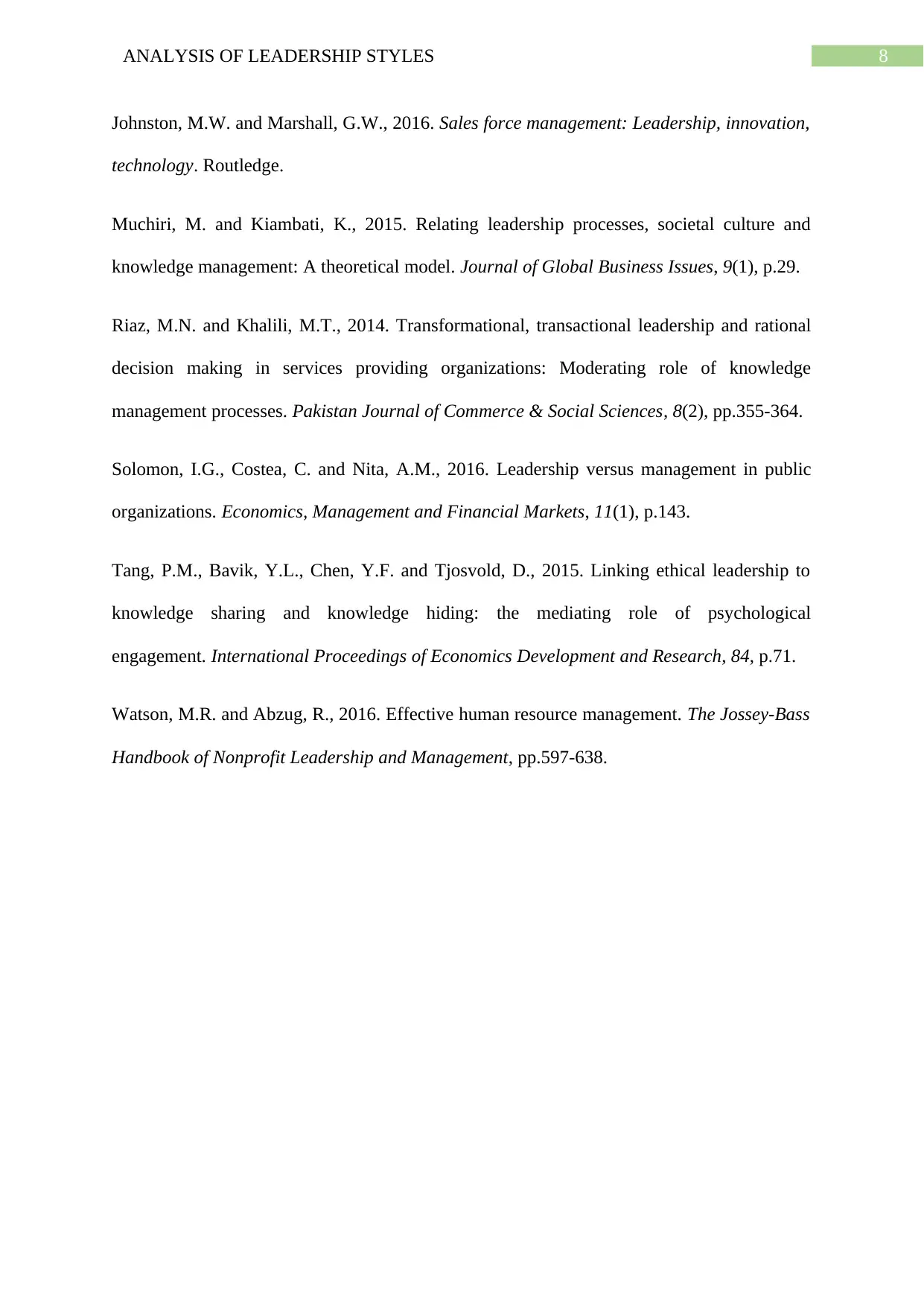
8ANALYSIS OF LEADERSHIP STYLES
Johnston, M.W. and Marshall, G.W., 2016. Sales force management: Leadership, innovation,
technology. Routledge.
Muchiri, M. and Kiambati, K., 2015. Relating leadership processes, societal culture and
knowledge management: A theoretical model. Journal of Global Business Issues, 9(1), p.29.
Riaz, M.N. and Khalili, M.T., 2014. Transformational, transactional leadership and rational
decision making in services providing organizations: Moderating role of knowledge
management processes. Pakistan Journal of Commerce & Social Sciences, 8(2), pp.355-364.
Solomon, I.G., Costea, C. and Nita, A.M., 2016. Leadership versus management in public
organizations. Economics, Management and Financial Markets, 11(1), p.143.
Tang, P.M., Bavik, Y.L., Chen, Y.F. and Tjosvold, D., 2015. Linking ethical leadership to
knowledge sharing and knowledge hiding: the mediating role of psychological
engagement. International Proceedings of Economics Development and Research, 84, p.71.
Watson, M.R. and Abzug, R., 2016. Effective human resource management. The Jossey‐Bass
Handbook of Nonprofit Leadership and Management, pp.597-638.
Johnston, M.W. and Marshall, G.W., 2016. Sales force management: Leadership, innovation,
technology. Routledge.
Muchiri, M. and Kiambati, K., 2015. Relating leadership processes, societal culture and
knowledge management: A theoretical model. Journal of Global Business Issues, 9(1), p.29.
Riaz, M.N. and Khalili, M.T., 2014. Transformational, transactional leadership and rational
decision making in services providing organizations: Moderating role of knowledge
management processes. Pakistan Journal of Commerce & Social Sciences, 8(2), pp.355-364.
Solomon, I.G., Costea, C. and Nita, A.M., 2016. Leadership versus management in public
organizations. Economics, Management and Financial Markets, 11(1), p.143.
Tang, P.M., Bavik, Y.L., Chen, Y.F. and Tjosvold, D., 2015. Linking ethical leadership to
knowledge sharing and knowledge hiding: the mediating role of psychological
engagement. International Proceedings of Economics Development and Research, 84, p.71.
Watson, M.R. and Abzug, R., 2016. Effective human resource management. The Jossey‐Bass
Handbook of Nonprofit Leadership and Management, pp.597-638.
⊘ This is a preview!⊘
Do you want full access?
Subscribe today to unlock all pages.

Trusted by 1+ million students worldwide
1 out of 9
Related Documents
Your All-in-One AI-Powered Toolkit for Academic Success.
+13062052269
info@desklib.com
Available 24*7 on WhatsApp / Email
![[object Object]](/_next/static/media/star-bottom.7253800d.svg)
Unlock your academic potential
Copyright © 2020–2025 A2Z Services. All Rights Reserved. Developed and managed by ZUCOL.





